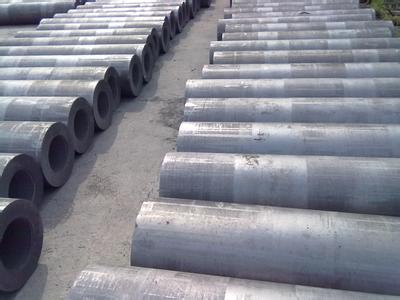

High-power graphite electrodes are widely used in various industries, including steelmaking, non-ferrous metal smelting, and silicon smelting. In steelmaking, the electrodes are used for electric arc furnace (EAF) steelmaking and ladle refining furnace (LF) steelmaking. In non-ferrous metal smelting, the electrodes are used for aluminum smelting, copper smelting, and magnesium smelting. In silicon smelting, the electrodes are used for silicon smelting and phosphorus smelting. The performance of the electrodes directly affects the quality and efficiency of the smelting process. In recent years, the demand for high-power graphite electrodes has increased significantly, especially for ultra-high-power graphite electrodes.
The development of high-power graphite electrodes
The production of high-power graphite electrodes involves the following steps:
1. Raw material preparation: Graphite electrodes require high-quality graphite raw materials. Generally, graphite raw materials should be high-purity, high-crystalline, and have uniform particle sizes. These characteristics can ensure that graphite electrodes have good conductivity and heat resistance during use.
2. Graphite processing: Graphite raw materials need to undergo processing steps such as grinding, mixing, and extrusion. These steps can make the raw materials form a uniform mixture and give the graphite materials certain strength and density.
3. Shaping: Processed graphite materials need to be shaped. Forming methods include pressing, extruding, molding, and injection molding. Through shaping, graphite materials can form electrodes of specific shapes and sizes.
4. Drying: The shaped electrodes need to be dried. This process can remove the moisture and volatile substances inside the electrodes, and improve the stability and heat resistance of the electrodes.
5. Sintering: The dried electrodes need to be sintered. Sintering is placing the electrodes in a high-temperature and high-pressure environment, causing changes in the internal structure, thus improving the conductivity and heat resistance of the electrodes.
6. Machining: The sintered electrodes need to be machined to meet the requirements of different application scenarios. Machining methods include milling, cutting, and drilling.
7. Testing: The final step of the manufacturing process is testing. This step requires comprehensive testing of the quality of the electrodes to ensure that they can meet the requirements during use.
Applications of high-power graphite electrodes
High-power graphite electrodes are widely used in the steel and other metal industries. In the steel production process, high-power graphite electrodes are used for electric arc furnace melting, ladle refining, and casting. In other metal industries, high-power graphite electrodes are used for aluminum smelting, copper smelting, and electrolytic copper.
Ultra-high-power graphite electrodes are widely used in large-capacity electric arc furnaces. Compared with conventional graphite electrodes, ultra-high-power graphite electrodes have higher current-carrying capacity and better thermal shock resistance, which can significantly improve the efficiency of steelmaking and reduce production costs.
Conclusion
High-power graphite electrodes are important components in the steel and other metal industries. High-power graphite electrodes have high thermal conductivity, high electrical conductivity, and good thermal shock resistance, which can ensure the efficiency and quality of the smelting process. The demand for high-power graphite electrodes has increased significantly in recent years, especially for ultra-high-power graphite electrodes. The production of high-power graphite electrodes requires strict quality control throughout the manufacturing process, including raw material preparation, graphite processing, shaping, drying, sintering, machining, and testing.
